TechRadar Verdict
This TV is well worth a look if you're looking to spend up to £1000 on a 4K that handles 4K, HD and SD pictures equally well. It's also HDR compatible but lacks the finesse of larger models - that shouldn't worry you if you know you're not going to ever spend more than a grand on a TV.
Pros
- +
Firefox OS
- +
4K detail
- +
HD & SD sources
- +
File handling
- +
Freeview Play app
Cons
- -
HDR lacks sparkle
- -
Tight viewing angle
- -
Some light leakage
Why you can trust TechRadar
If you're after a 4K that can also dabble in the world of high dynamic range pictures from Netflix, Amazon and Ultra HD Blu-ray, the Panasonic DX700 is well worth a look.
HDR TVs are able to display very bright and very dark areas on the screen at the same time without losing any detail. Whites aren't washed out and blacks are still full of perceptible details.
That's how it's supposed to work anyway. But as it happens not all HDR TV's are born equal, and as the cheapest range of Panasonic HDR TVs out there the HDR features in this TV are noticeably weaker against more expensive sets. We'll come back to this.
The TV we discuss here is the 58-inch model in the DX700 series. It's available at closer £1000 on launch, £200 more than the 50-inch TX-50DX700 and £450 more pricey than the 40-inch TX-40DX700 we reviewed back in May. This is a mini review so if you want lots more detail on the DX700, check out Jamie Carter's extensive review of the 40-inch version.
One of the key reasons to choose Panasonic over a Sony or Samsung right now is the excellent FirefoxOS smart TV system. It just works in ways that Android TV doesn't do consistently and is easily a match for LG's webOS system. We prefer it over Samsung' s Tizen system too but really this is all personal preference.
What you can take to the bank is that FirefoxOS is rock solid as a platform, can be integrated with your web browser and will even communicate with other devices around your home if they also run FirefoxOS (hello Mr Washing Machine!).
Netflix, BBC iPlayer, Amazon Prime (HDR from Amazon Prime will be supported after a forthcoming firmware update), Plex - all of the features and functionality you'd expect are there waiting for you.
Picture quality
Picture quality on the DX700 is excellent in many areas and never drops below the level of adequate. It's an entry level series when it comes to HDR but it's more like midrange when you consider that the DX600 series is more or less exactly the same without HDR compatibility.
So you could argue that a recommendation to buy the DX700 hinges on its HDR performance and sadly this is where this series starts to come unhinged. As Jamie Carter noted in his extensive 40DX700 test, HDR footage streamed from Netflix - specifically Marco Polo season one - failed to really impress as it perhaps should.
While the TV can technically display a higher dynamic range compared to the cheaper DX600 series, it lacks the chops to really allow the extra picture information to do its mesmerising. Yes it's better than non-HDR but is it worth the extra cash? Hold that thought.
This all being said, general 4K pictures look great and so does standard definition which is often where cheap 4K TVs come unstuck. 4K, HD and SD images are all handled competently with even fast-moving pictures rendered nicely by Panasonic's long-impressive Intelligent Frame Creation motion smoothing.
Verdict
At £1000 this TV is not a cheap option but it just about proves its worth. If you're going to go for a big TV like this, it's a smart move to try and future proof yourself and that means going for an HDR model. That'll enable you to pick up an Ultra HD Blu-ray player down the line without missing out on some of the picture detail. That being said, while 4K, HD and SD pictures are all decent, HDR doesn't quite wow like it does on more expensive models but that's the price you pay for not dishing out more money on a costlier model.
This article is based on the Panasonic TX-40DX700 review that techradar published in May 2016
James was part of the TechRadar editorial team for eight years up until 2015 and now works in a senior position for TR's parent company Future. An experienced Content Director with a demonstrated history of working in the media production industry. Skilled in Search Engine Optimization (SEO), E-commerce Optimization, Journalism, Digital Marketing, and Social Media. James can do it all.

